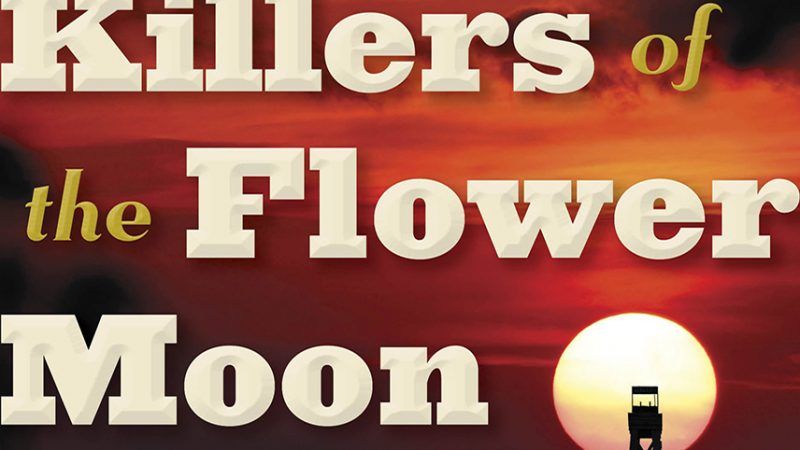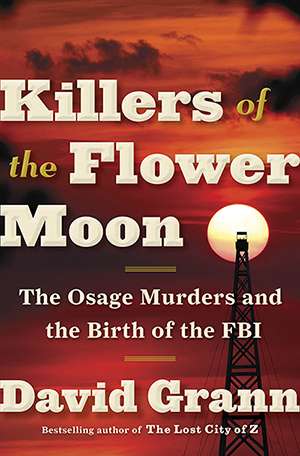Blood for Oil
A covert war with the Osage Nation

Killers of the Flower Moon: The Osage Murders and the Birth of the FBI, by David Grann, Doubleday, 352 pages, $28.95

For more than a decade, members of the Osage Nation in Oklahoma were quietly, systematically slaughtered for their oil money.
In Killers of the Flower Moon, journalist David Grann describes how Congress made the Osage dependent on whites who could gain from their deaths and how leading Oklahomans conspired to perpetrate and cover up mass murder. He shows how a federal agent struck a blow against the killers, but he also reveals that the murders took place over a longer period of time, and claimed far more victims, than the government investigation suggested. It is, as Grann told one interviewer, a story of how "a system rooted in racism, done under the pretense of enlightenment," produced a "criminal enterprise that had been sanctioned by the U.S. government."
As Grann's narrative begins, the Osage people—who twice had been forced to relocate, once from their traditional land in present-day Missouri, Arkansas, and Oklahoma, and once from the Kansas territory the U.S. government had promised would be their permanent home—were reaping their reward for settling in a portion of north-central Oklahoma that no one else wanted. They had secured the rights not just to the soil but to the minerals beneath it.
That poor, rocky land sat on top of oil. By the 1920s, the oil boom was making the Osage people immensely wealthy. The year 1923 alone brought in over $30 million in royalties (more than $400 million* today). As one magazine writer put it at the time, "Every time a new well is drilled the Indians are that much richer.…The Osage Indians are becoming so rich that something will have to be done about it."
Something was done about it. Under the guise of protecting the Osage from their money for their own good—white man's burden, don't you know—Congress in 1921 passed a law requiring Osage individuals to be appointed white male guardians until they could prove that they were competent. In practice, the greater the percentage of Osage blood one had, the more difficult it was to prove competence. And the whites who controlled the purse strings had a strong incentive to collude to rob and defraud their dependents.
They also had an incentive to murder. An Osage individual's headright claim to oil revenues passed on to his or her legal heir, regardless of blood quantum or tribal affiliation.
The first section of Grann's book is aptly titled "The Marked Woman." Mollie Burkhart was literally the last woman standing in her Osage family after her mother was poisoned, one sister was shot, and another sister was killed in an explosion. With each death, the headrights and the wealth they represented accumulated. Mollie herself would be attacked—white doctors in on the conspiracy professed to give the diabetic woman insulin while actually injecting her with poison—but ultimately was saved.
The experience she had of mysterious death after mysterious death in her family, and her justified sense that she herself was being hunted, offer a taste of the terror endured by the Osage. Grann quotes the historian Louis F. Burns: "I don't know of a single Osage family which didn't lose at least one family member because of the head rights."
Mollie's story also underscores the insidiously personal long-term betrayal represented by the killings. She would eventually learn that the white man she believed to be her loving husband and the caring father of her children was, in fact, acting on a scheme concocted by his powerful cattleman uncle, William "King of the Osage Hills" Hale, to infiltrate her family, murder its members, and inherit their oil revenues.
The murderers didn't limit themselves to killing the Osage. Knowing they couldn't trust local law enforcement, some tribal members asked a white friend, oilman Barney McBride, to go to Washington, D.C., on their behalf and request a federal investigation into the deaths. He agreed. The day after he arrived in the nation's capital, his naked body was found with over 20 stab wounds. When Pawhuska attorney W.W. Vaughan tried to move a private investigation forward, he was stripped and thrown from a train. The message was clear: The reach of the Oklahoma conspirators was long.
By this point the national press was paying attention. Twenty-four known murders (and likely many more) demanded justice, and newspapers spread the word about "an evidently well-organized band, diabolic in its ruthlessness, to destroy with bullet, poison, and bomb the heirs to the oil-rich lands of the Osage." Whoever could crack the case would be celebrated as a hero.
Enter J. Edgar Hoover.
To be clear, Hoover is not the hero of this story. Inheriting a 16-year-old Bureau of Investigation (the Federal was not added to its name until later) known mostly for its corruption, the 29-year-old Hoover had never been a detective. He was a career bureaucrat—in Grann's words, a "deskbound functionary" obsessed with "organization and social control." But after a bungling first run at the Osage case, Hoover turned the investigation over to a team staffed by the very kind of agents he wanted to purge from the organization for not being suit-wearing, college-educated, dutiful filers of Efficiency Rating sheets. The team was led by former Texas Ranger Tom White, who successfully identified conspiracy mastermind William Hale and some of his comrades.
After the conspirators were convicted, Hoover did all he could to steal the media attention, assume credit for White's achievements, and harness the momentum to further empower his agency. He also sent the Osage a bill for more than $20,000. Federal justice came with a price tag.
Hoover's interest in the case had little to do with any concern for vulnerable minorities in general or Native American lives specifically, to judge from the surveillance and harassment he later inflicted on civil rights and American Indian activists. Grann links his bigotry and desire for personal control to his Progressive Era roots. "An ugliness often lurked beneath the reformist zeal of Progressivism," he notes. "Many Progressives—who tended to be middle-class white Protestants—held deep prejudices against immigrants and blacks and were so convinced of their own virtuous authority that they disdained democratic procedures. This part of Progressivism mirrored Hoover's darkest impulses."
Grann's chronicle of White's investigation and the subsequent trials reads like the most thrilling fiction, complete with what appears to be a satisfying resolution. But then we reach the final section of the book, which covers Grann's more contemporary research, and everything we think we've learned changes.
The FBI inquiry, it turns out, showed just part of the story of the mass murders in Osage County. The traditional narrative defines the "Reign of Terror" as the crime spree of Hale's circle, beginning in 1921 and ending with Hale's arrest in 1926. But with primary sources, secondary written accounts, and contemporary interviews, Grann demonstrates that the assault began at least as early as 1918 and stretched to 1931, if not later.
Grann's chilling conclusion: "the murders of the Osage for their headrights were not the result of a single conspiracy orchestrated by Hale. He might have led the bloodiest and longest killing spree. But there were countless other killings—killings that were not included in official estimates and that…were never investigated or even classified as homicides." The system of putting white guardians in charge of wealthy Osage with transferable headrights had appealed to the very worst in human nature and rendered the targets all but helpless. Osage County became a killing field, and an unknown number of murderers were never held accountable for their crimes.
In a sense, the Osage murders were a 20th century sequel to the Indian wars: one more entry in a long list of times white people have used the state to expropriate resources from Native Americans. (That list continues today, as the feds mismanage the funds they hold in trust. The Cherokee Nation is currently suing the U.S. government for being, in the tribal secretary of state's words, "a black box of information as to Cherokee Nation's resources.") What sets the Osage tragedy apart from its precursors is that the nature of the murders makes it difficult to identify the victims. White doctors, coroners, and law enforcement officials cooperated to make many of the Osage deaths appear natural, accidental, or self-inflicted.
Worse still, the conspirators insinuated themselves into the communities, families, and hearts of the victims before striking. Native peoples had ample cause to expect a threat from the outside. But as Grann writes, the Osage faced wolves "living among them in sheep's clothing," leaving an especially brutal legacy of pain and horror.
*CORRECTION: Due to a typo, the print version of this article said billion instead of million.
